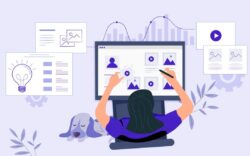
Who is a UX/UI designer?
A UI/UX designer is a creative person who designs user interfaces. UI and UX are two different design profiles, but more often than not, tasks in both areas are closely related, and therefore they are done by one universal specialist.
This profession has a long history. Any customization of the appearance of the product (packaging, ergonomics, outdoor advertising) can be called UI / UX design because with its help the final product becomes convenient for the end-user. The only difference is that modern UI/UX designers employ digital tools rather than pan and paper.
As a rule, a UI designer works in a duo with a UX designer, but according to recent trends, the duties of both employees have become consolidated in one role – a UI / UX designer.
UI stands for “user interface”, and UX for “user experience”. The UI designer is responsible for visualizing the application and making it user-friendly and functional. In order for the product to be easy on the eyes of the user, the UI specialist is responsible for the selection of shapes, colours, and other parameters. As for the UX designer, they are more responsible for the functionality of the design, making sure the application is easy and convenient to use.

What is UX Design?
UX is the experience of interacting with the interface of an application or website. The user experience depends on the following components: graphic design, site architecture, responsive interface, and clear text.
In a broader sense, it refers to the entire experience that a user gets when interacting with an application or website. The clearer and more accessible the interface, the easier it is for the user to perform the desired action. Mandatory responsibilities in UX design include prototyping behaviours, studying user habits, and systematic testing.
What is UI Design?
UI design is the work done on the graphics part of the interface. This includes animations, photos, illustrations, buttons, menus, fonts, sliders.
The main task of a UI designer is to help a typical user quickly and easily understand how to use a product. This can be a website, an application, a payment terminal, a TV remote control, or an oven. In any product, the interface must be based on the requirements and rules common to each type of gadget.
The UI designer “conducts” the objects in the interface and checks:
- Is the drop-down menu working properly?
- Is it convenient to click “Order”?
- Is the text readable on a smartphone?
- Is it easy to fill out any forms?
- Does the site give the correct message when an action is taken?
The UI designer is responsible for how the product interface looks and how the user interacts with its elements. But you need to understand that in addition to the graphical interface, there is also voice, tactility, and sound. These are also dealt with by a UI specialist, but graphics are the most common among their tasks.

Responsibilities of a UI/UX designer
What kind of work a UI/UX designer does is determined by the responsibilities of both sides of their profession. By combining tasks for each area of interface development, we will get a complex picture of the duties of a UI / UX specialist.
The main task of a UI designer is to help the user easily understand how to interact with the product. To achieve this, you need to know programming, the psychological aspects of colours, and graphic design, as well as have a sense of style.
Main responsibilities of a UI designer:
- designing custom pages and screens
- harmonising graphic elements with corporate identity
- drawing buttons, blocks, sliders, switches
- drafting up a manual for creating a software product
- layout
UX design has more to do with product structure and user experience. User Experience Designers tend to have a wide range of skills, such as graphic design, target audience research, and software development.
Key responsibilities of a UX designer:
- conducting user surveys
- creating a portrait of the target audience
- development of a working prototype of the product
- creation of a logical chain of product use
- testing, and adapting based on results
- repeat the sequence of “prototype – test – make changes” until you achieve the optimal experience for users.
How to become a UI\UX designer
- Choose your path in design
The choice depends on personal preferences and interests. Here is a clear and convenient scheme by which you can find what appeals to you most and get a ready-made specialty:
- The purely visual part of the design is in the hands of UI designers
- The logic of the product, user-friendly interface, analysis, and testing – user experience (UX) designers.
- A mix of the first and second with an in-depth study of the product – product designers (Product Design).
- The layout of magazines, leaflets, banners; company identity – graphic designers (Graphic Design).
- Learn the tools for the job
Beginners should start right away with Sketch or Figma. But it is recommended to have basic skills in Adobe Photoshop and Illustrator too, since these programs often come in handy.
If you have already decided on UI \ UX in design, you need to study vacancies in this area. They clearly indicate the tools that the candidate for the position must possess.
What tools a UI / UX designer needs to have under their belt:
- Sketch (interface design)
- Figma (interface design in a team)
- Adobe Photoshop and Illustrator (additional functionality)
- Adobe XD (prototyping, interface design)
- Invision App (collaborative prototyping)
- Balsamiq (layout creation)
- RedPen (collective problem book)
- Notion (task manager)
- Framer (interactive mobile interface design)
- Pay attention to design. Surround yourself with design
If you decide to become an interface designer, it’s time to pay attention to all the details. You will notice how questions will form in parallel in your head: why is this logo here, why is the font exactly the way it is, why this colour scheme and not another?
It is necessary to study the structure of sites, paying attention to the details, answering questions in your head, and studying the theory. This way you will begin to look at the site not only from a user’s point of view but also from a professional one.
Drawing inspiration and learning from others is an integral part of a successful UI/UX designer’s career path. Here are some popular services to help you with that:
- Awwwards (award platform)
- Behance (portfolio platform)
- Dribbble (portfolio platform)
This practice will help you fully integrate into the world of design. You will begin to distinguish between good and bad design, and learn to identify the necessary and unnecessary elements. Feel free to copy in an attempt to create something unique. Each new page you make, and each application design is an important additional block in the portfolio. If you eventually develop your own style and vision, you are on the right track.

- Follow what others are doing
Professional designers often become mentors – those who share their experiences on blogs and social networks. Find like-minded designers and follow their creative activities. As a rule, their life consists almost entirely of work. Here are some of them:
- Artemiy Lebedev, designer, author of the “Guidance” – a guide to web design
- Tobias van Schneider, ex-Spotify designer.
- Julie Zhuo is Facebook’s VP of Product Design.
Why not try your hand at mentoring? This is a great experience that will help you find shortcomings and omissions in your study/work. Moreover, rehearsing newly acquired knowledge will help reinforce what you learned.
- Get trained
The future UI / UX specialist has a choice: watch videos on YouTube, read books and articles, or take specialised courses. There is no definitive answer, but the second option will take less time and improve the UI/UX designer’s resume. An example of practical and effective training is the UI/UX DESIGN course by DAN.IT.
The program provides a full overview of the skills required to work as a designer in large companies around the world. During your UI/UX design training, you will master all the modern tools for working with the projects of real customers according to the latest trends. We place great emphasis on learning from scratch: even a beginner should be able to master the basics of Photoshop we explore in the web design pre-course. Most importantly, the program is created in such a way as to teach a novice in the field to execute a design task from end to end. You will go through all the stages of building the perfect design layout for a website or application.
Pros and cons of being a UI/UX designer
Pros:
- In-demand career
- Above-average salary level
- Opportunity to be creative
- Prospects for the development of professional skills and branching out to related fields.
- Ability to work remotely
Cons:
- Great responsibility for the finished product
- Constant research into user behaviour
- Need to combine skills from several areas at once
- Often you need to adapt to customer requirements (not always optimal)
- Frequently mundane tasks
How in demand is a UI/UX designer?
Your demand on the job market depends on experience, skills, and portfolio. All this should be clearly and understandably placed in your resume. The first thing a UI/UX designer needs to do is build a portfolio.

Possible career paths for a UI/UX designer:
- reach the position of Head of Design
- learn programming (to become a UI developer)
- develop as a Product Manager (to manage the product as a whole)
- become a Project Manager (to coordinate the activities of a team)
- improve and increase your rates (if a freelancer)
- become a product designer (VR designer, VFX designer, Game designer)
- try your hand at marketing.
Personal qualities that will serve you well as a designer:
- perfectionism
- perseverance
- creative thinking
- desire to learn and develop
- ability to take criticism.

How much does a UI/UX designer earn?
On average, a “UI/UX designer” in the UK earns £39,540
This number is provided by Glassdoor.
UI/UX designer: learning from scratch
Just starting out in UI/UX design? The UI / UX Design course at DAN.IT is suitable for both beginners and those who already have experience with interfaces.
The program provides a full overview of the skills required to work as a designer in large companies around the world. During your UI/UX design training, you will master all the modern tools for working with the projects of real customers according to the latest trends. We place great emphasis on learning from scratch: even a beginner should be able to master the basics of Photoshop we explore in the web design pre-course. Most importantly, the program is created in such a way as to teach a novice in the field to execute a design task from end to end. You will go through all the stages of building the perfect design layout for a website or application.
You will go through all the stages of building the perfect design layout for a website or application. We will teach you to interpret the customer’s directions, be attentive to their requests and business needs, analyse their niche and look for the perfect balance between trendy solutions and the client’s desires. A minimum of dry theory, emphasis on the practical solution of real problems – all await you at DAN.IT!
